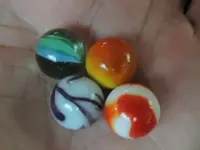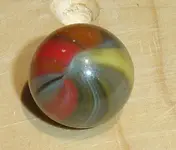Ok, I just got that feeling after having "differing opinions" in several different threads all of a sudden. I've moderated forums and participated in forums for long enough to recognize that when someone new pops in and starts telling everyone they're wrong on different threads, a pissing match is what they're after. I'm a southern boy. Thick skinned, but I speak my mind. Sometimes it's a good thing, sometimes it's a fault. I can keep a level head though.
There is such thing as a 4th color. When a 4th glass nozzle introduces another color to a 3 color marble, or added a 4th color to the tank, it is a 4th color. If Master used red glass in one nozzle, blue in one, yellow in one, and tan in one, that's 4 colors (I don't know if master used nozzles or what). They intentionally used 4 different chemically created recipes to have 4 colors in that marble. The resulting marble will look like some of those you posted with lots of shades and blends. You can say what you want about the colors all deriving from the primary colors, and that is true scientifically speaking, but it has nothing to do with the lingo in the marble collecting world and means nothing there. You don't mix yellow and blue glass to get green.
Creating colors in glass and making that glass stable took years of development for the marble companies. The recipes for their glass was a closely guarded secret in many cases. There was actually glass espionage, where spies from other companies would try to discover how another company made their glass. It wasn't as simple as melting some of this color and some of that color and mix them until you get the color you wanted.
In the marble world, different colors means actual glass color that is introduced into the marble. If you have a blue and yellow corkscrew, chances are there is also grey and/or brown in that marble. It doesn't matter, it's still only a 2 color corkscrew. You only count the colors used. There were two glass nozzles introducing glass, one blue, and one yellow. Normally blue and yellow make green, but that doesn't always work in glass. The chemicals used to make the different colors react with each other and make brown and grey. So, you can have a corkscrew with blue, yellow, brown, grey, and even dark streaks that look like black, but it's still 2 color marble. It's important because three color corkscrews were premium marbles for akro, so when they turned on a 3rd nozzle, it changed the marble's construction, making it more collectible. Same for Master and the other companies. Some colors do blend to make the color you would expect. That's usually with translucent or transparent glass. Sometimes red over white will make orange or pink, sometimes red over yellow will create orange, but it's usually one over the other making it look like orange. I see an example like that in the masters you posted. It has a big red cap and some yellow next to it with orange in between. In the marble world, that orange is not a color in that marble because Master didn't put orange glass in that marble.






